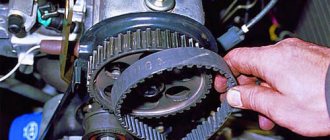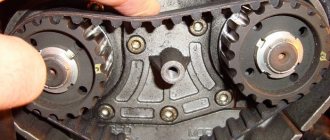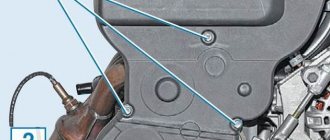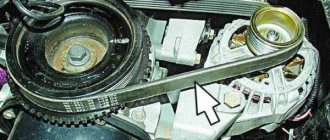Why does the timing belt slip and eat?
Tensioning the timing belt On many modern internal combustion engines, the timing belt is tensioned automatically; the mechanic only needs to fix the position of the tensioner roller. But there are also quite a few power plants where the belt is tensioned with manual checking. As a rule, the hands of an experienced craftsman cope with this task with a bang. It will be much more difficult for a beginner to do this. In this article we will try to provide recommendations and advice that will greatly facilitate the task of diagnosing the tension of the timing rubber ring.
Advantages and disadvantages of belt drive
The belt drive of the gas distribution mechanism has enough advantages, which is why it is widespread.
- The production of these belts, although complex, is much simpler and cheaper than a chain.
- The timing belt does not need lubrication, so it became possible to move the drive to the outside of the engine. This affected the ease of replacing it and checking its condition.
- Engine noise using a belt is significantly reduced due to the absence of metal-to-metal interaction, as is the case with a chain drive.
But the belt drive also has its disadvantages. Compared to a chain, a belt lasts significantly less. Reducing the chain tension leads to a maximum increase in noise during operation of the power plant; jumping onto the gears and breaking it is practically eliminated, which cannot be said about the belt.
VAZ "Ten"
A popular car equipped with an engine with a timing belt drive. The manufacturer recommends replacing the rubber band of the GRS mechanism after 40-45 thousand kilometers, but diagnostics cannot be neglected before this period. The principle of “installing a new belt and forgetting about it” must be eradicated, understanding that being guided by this rule will not lead to anything good.
Attention. It is very important to regularly diagnose the technical condition of the belt and its tension.
In order to check the tension today, special electronic devices are used, although you can do without them. Only on the timing rubber product itself there should not be a drop of oil, dirt or signs of tear. Everything must be almost perfectly clean, without delamination, for the diagnosis to be most effective. Otherwise, it is better not to bother with diagnostics, but to immediately replace the belt with a new one, eliminating the reason why it was worn out or lubricant got on it.
Checking tension with a steelyard
Another important condition: the check must be carried out on a cold internal combustion engine.
The checking and adjustment process itself is as follows:
Now directly about the diagnostic process:
Attention. If the tension is accurate, the deflection should be 5.4 mm. Otherwise, adjustments will have to be made. If the value is less, then the tension is too strong; if it is more, the belt is too loose.
The adjustment is carried out as follows:
Note. The nut should be fixed so that the roller does not move and cannot be released.
It is also important to remember that excessive tension on the rubber timing ring reduces its service life and can easily lead to failure of the tensioner roller and even the pump. You should not listen to those false masters who claim that strong tension will supposedly eliminate all problems with the belt.
Weak tension always means the belt jumps over the teeth of the camshaft sprocket, which inevitably leads to disruption of the phases of the hydraulic valve mechanism. On the contrary, a strong tension is wear by the bearing of the same roller or water pump, as well as direct wear of the belt.
The tension can also be checked using a special device, such as “Contiteg”. The principle of its operation is quite simple, you just need to measure the amplitude of the belt vibrations.
The device always comes with a detailed description of its operation in a case. It consists of a device with readings, as well as a sensor, which must be brought to the belt (at a distance of 1 cm).
Attention. It is extremely important that the sensor “overlaps” the belt with only half its length.
Signs of a bad timing belt
Signs indicating failure:
- Cracks, visible dirt, chips, cuts, poor tension, beating.
- Black exhaust smoke. As a result of incomplete combustion of the mixture, fuel enters the exhaust system.
- Increasing the operating temperature of the motor. The increase is due to a shift in the valve timing, which occurs when the belt stretches.
- Problems with the ignition system when starting, uneven operation, and missed detonation may be the result of belt wear, in which the teeth “slip.”
- A stretched belt can cause increased fuel consumption and reduced power.
- Extraneous noise.
If these symptoms appear, you should contact a car service center as soon as possible.
How to tighten the timing belt of a VAZ
Author KakSimply! The timing belt is one of the main ones in engine drive. Its main job is to synchronize the rotation of the crankshaft and camshaft. Therefore, you should periodically monitor its technical condition and, if defects are detected, replace it. In addition, it should be properly tensioned so that it can be fully used.
Check the technical condition of the timing belt. Its surface of the toothed part must have a clear tooth profile, not be worn out, have no cracks, folds, peeling of fabric from rubber and undercuts. Pay attention to the integrity of the end surfaces; there should be no fraying or delamination on them; only a slight protrusion of the fabric fringe is allowed. Inspect the surface of the outer flat part, it should be smooth and free of cracks, folds, bulges and depressions. There should be no engine oil on the timing belt. If any of the defects are found, replace it.
Remove the generator and pump drive belt, and then the upper protective cover. Set the first cylinder to TDC by aligning the mark on the crankshaft pulley with the middle mark on the protective cover, and the mark on the camshaft pulley with the mark on the cylinder head cover. Using a 10mm socket, unscrew the nuts of the middle and lower protective covers and remove them. Disconnect the spring, loosen the bolts and move the tension roller bracket to the left until it stops. Remove the timing belt.
Check the belt tension mechanism. To do this, inspect the working surface of the roller; it should be smooth and free of burrs and nicks. Its bearing should rotate without jamming and smoothly. Check the elasticity of the tension spring; if it is weakened, replace it. Install a new belt. To do this, put it on the crankshaft toothed pulley and, pulling it, put it on the oil pump drive pulley, and then on the camshaft pulley. After placing the belt on the tension roller, install the spring by pressing the bracket to the right. Keep the timing belt tensioned and turn the crankshaft two turns without jerking. Do not loosen it when stopping the shaft. At this point, the spring will automatically set its tension. Secure the bolts. Check the alignment of the marks on the crankshaft and camshaft. If they do not match, reinstall the belt. Install the protective covers and tighten the nuts.
How to tighten the timing belt of a VAZ
After how many kilometers should the timing belt be changed?
The vehicle's operating instructions indicate the recommended service life of each part. The belt should be replaced not according to the prescribed regulations, but according to the fact of its wear.
This is useful to know: Is running-in of a new car necessary and how to do it correctly
For example, some domestic manufacturers indicate in the manual that the belt on automotive products is designed for 180 thousand km. mileage A motorist with extensive experience will doubt the veracity of such data.
The service life of a car part depends on several factors:
- Quality of roads;
- Belt brands;
- Car models.
Thus, a timing drive from well-known manufacturers, installed on a Renault car when used in Russia, must be replaced after a run of 60 thousand km, and when driving on European roads, after 120 thousand km.
Important! It is recommended to replace the part together with the tension roller, pulleys and water pump.
Volkswagen
As you know, Volkswagen cars are equipped with timing belts and chains. According to the service book, the belt tension should be carried out so that one branch of the belt can be rotated 90*, as is the case with the Audi. Only here a few questions arise.
Timing belt tension on Volkswagen Passat
For example, one of them concerns the rotation force of the belt. Some people have strong fingers, others have weak ones. For this reason, it is recommended to carry out a combined tension and take the average value. More details below:
You should push off from the golden mean, when the belt does not clap or make noise.
Malfunctions of the electrical equipment of the car
The main reason for the decrease in generator performance is the weakening of the belt tension. But before you approve anything, it is necessary to diagnose the electrical equipment of the car. Signs and causes of malfunctions of on-board network devices:
The main reason for the decrease in generator performance is the weakening of the belt tension.
- headlights flicker when the engine is running;
- The alternator belt whistles when starting on a cold engine;
- when using electrical appliances, fuel consumption increases significantly;
- extraneous noise in the drive belt area;
- The generator belt tensioner roller whistles;
- The battery is often ;
- mechanical damage to the belt and roller.
The worst thing that can happen to the belt is a break, and the roller can jam. In these cases, the generator will not work, and its functions will be taken over by the battery. But the battery will not last long because it has limited capacity. The main purpose of the battery is to supply the starter with starting current for reliable starting of the engine. The generator, among other things, performs the function of recharging the battery.
How to install and correctly tension the timing belt on a VAZ-2114: video
The timing belt must have a strictly defined tension.
If the tension is insufficient, it can hit the casing or jump over the teeth, which can lead to a violation of the valve timing.
What are the consequences of incorrect timing belt tension for the VAZ-2114 engine?
The timing belt has almost slipped. Pay attention to the gap from the belt to the engine, it is uneven
If the belt is significantly displaced, a picture similar to its complete break may be observed. Therefore, it is necessary to pay serious attention to the correct tension of the timing belt, both when replacing it and during operation of the vehicle. You can do this yourself, but be careful and be sure to follow the instructions below.
Proper tension (order and process)
Before you begin tensioning the timing belt, you must turn off the engine after idling in neutral gear. In this case, the engine crankshaft will stop in a position where all the forces acting on it will be balanced. Now let's start tensioning.
Video of replacing and tensioning the timing belt on a VAZ-2114
conclusions
Incorrect timing belt tension will lead to accelerated wear.
Accelerated wear of the timing belt due to incorrect tightening.
The engine on a VAZ-2114 does not bend the valve when the timing belt breaks, but still, there is a risk of getting up at night in a dark field in our big country. You will be lucky if the belt breaks at home or at work, and not on a long trip. To prevent this from happening, you need to set the timing belt correctly, as we wrote above!
Source
Why does the belt need to be tensioned?
Because it operates under high voltage, over time the tire that makes up the belt begins to relax and stretch slightly. And when it stretches, problems begin with engine components, because without belt drive they cannot perform their functions.
A loose coil belt can not only jeopardize the performance of engine components, but it can also cause internal damage to the engine itself, and then you will have to completely rebuild your car's engine or, worse, buy a new vehicle.
How can you tell if a track belt is stretched?
Look at the warning light on your car's dashboard - most modern cars have a warning light that shows the battery voltage when you start the engine. If the belt is not tight, it will not be able to rotate the alternator pulley, causing a drop in electrical current to the car's engine, which in turn will cause the warning light on the dashboard to turn on. Attention! The light may be on not because of belt tension, but because of problems with the battery or alternator.
Pay attention to engine temperature - if the timing belt is too tight, it may not supply enough water to the water pump and this will cause the engine temperature to rise, which will not be able to cool effectively. Listen for unusual noises or squeaks in the engine area - Squeaks are one of the first signs that the belt is loose, and if you hear them when you start the car when the engine is cold, or hear them when accelerating, then it's time to think about tightening the belt.











